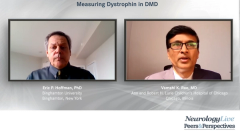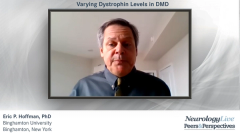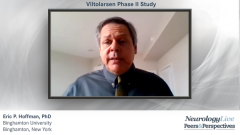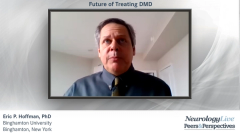
Exon Skipping Agents Used in DMD
A review of exon skipping agents, their function, mechanism of action, and the different drugs used in clinical practice to treat Duchene muscular dystropy.
Episodes in this series

Vamshi K. Rao, MD: Let‘s switch gears to something very positive going on in the field: the availability of exon skipping treatments. As we all know, the first treatment to be approved was an exon 51 skipping agent, which was later christened as eteplirsen. We subsequently had approval for 2 drugs that are exon 53 skipping agents: golodirsen and viltolarsen. Very recently, the exon 45 skipping drug casimersen was approved. Can you talk a little about exon skipping? You alluded to it earlier, but can you talk a little about the differences of these different agents? At the synthetic level, what is the difference between these agents and their backbones?
Eric P. Hoffman, PhD: Sure. Exon skipping is a fascinating area of therapeutics. It’s one of the first drugs meant to help the gene fix itself. It’s a small snippet—about 20 bases of sequence—that’s delivered IV [intravenously]. It goes all the way into the nuclei of the muscle. As the dystrophin gene is transcribing from DNA to RNA and then to protein, it binds to the RNA. In Duchenne muscular dystrophy, the gene is inactive. It’s trying to make RNA, but its RNA is nonfunctional. This snippet comes in and basically splices and helps repair the RNA to make it like in Becker muscular dystrophy, where it can make dystrophin. The real-time fixing of the gene mutation as it’s being transcribed and translated is fascinating. It’s also fascinating that it works to some extent, because getting those oligonucleotides through the bloodstream, throughout the muscle, and to all the nuclei and RNAs is a tour de force.
As you mentioned, there are 4 drugs. That’s because you have to tailor the drug for the gene’s mutation. To fix the mutation, you can’t use any generic place in the gene. You have to target exactly where that patient’s mutation is. Right next to it, the drug helps fix it or skip over the mutation, which is why it’s called exon skipping. About 10% of kids with Duchenne muscular dystrophy have mutations that are amenable to exon 51 skipping, or the eteplirsen drug. The other 90% don’t, because their mutations are not amenable. Likewise, 8% or 10% of patients have mutations that are amenable to exon 45, with another 10% amenable to exon 53. These different drugs target different subsets of patients who have Duchenne muscular dystrophy.
Vamshi K. Rao, MD: Let’s start by talking about one of these drugs. As we look at these drugs, these synthetic oligonucleotides, the way the body eliminates them is through the renal system. Safety-wise, one of the things we are all looking for is to monitor renal function, although most of these trials haven’t shown a serious effect on the renal system, particularly the kidney. Overall, these drugs have been very safe. They have been tolerated well. Most of the safety signals have been at the level of adverse events rather than serious adverse events. There have been no deaths reported. Needless to say, these exon skipping drugs are very safe. All of them are administered IV weekly. There is a lot of work going on to see how they can be altered so they don’t have to be administered every week. Once a month would be wonderful in terms of patient compliance and overall convenience.
As we think about these drugs, let’s look at the 2 exon 53 skipping drugs: viltolarsen and golodirsen. Based on the clinical trial data, what differences have you seen in what the publications have shown? You and I have been intimately involved in the exon 53 viltolarsen study. What is the difference between golodirsen and viltolarsen?
Eric P. Hoffman, PhD: Your description is very accurate. A lot of the drug hits the kidney and is excreted right away. A very small fraction ends up actually hitting the gene target in the muscle or the messenger of any target. There’s so much room for improving this, as you outlined. The drug load to the kidney is significant because it is so rapidly excreted.
We say it’s a snippet of DNA or RNA, but interestingly, it’s a different chemistry called morpholino chemistry. It is not biological per se. It’s a highly modified chemistry. If you look at it at first blush, it looks like DNA/RNA with the bases and ribose backbone. But the ribose backbone is replaced with a completely alien structure called a morpholine ring. That turns out to be a huge advantage because the body does not see it as something biological, or worst-case scenario, as a virus. Most of our exogenous DNA or RNA coming at us is a virus, and our body freaks out and wants to get rid of it as soon as it can. These morpholinos do not invoke any antiviral or innate immunity and they’re not metabolized. They stay intact, which is good. But then the body says, “This is just garbage, let’s get it out in the kidney,” and that’s why it ends up in the kidney.
Any efforts to try to keep targeting, to get more into the muscle and have it stay there longer, are really important. There are lots of efforts underway to try to do that. Even how it gets into the muscle is interesting. It seems to be brokered by macrophages. The macrophages may take it up to try to protect the body, and then in remodeling dystrophic muscle, degeneration/regeneration, seems to release it back into the muscle. There’s a recent publication on that. It’s all very complicated with a lot of room for improvement.
Vamshi K. Rao, MD: I thank all of you for watching this NeurologyLive® Peers & Perspectives®. If you enjoyed the content, please subscribe to our newsletters to receive upcoming programs and other great content in your inbox. Thank you.
Transcript Edited for Clarity
Newsletter
Keep your finger on the pulse of neurology—subscribe to NeurologyLive for expert interviews, new data, and breakthrough treatment updates.




































